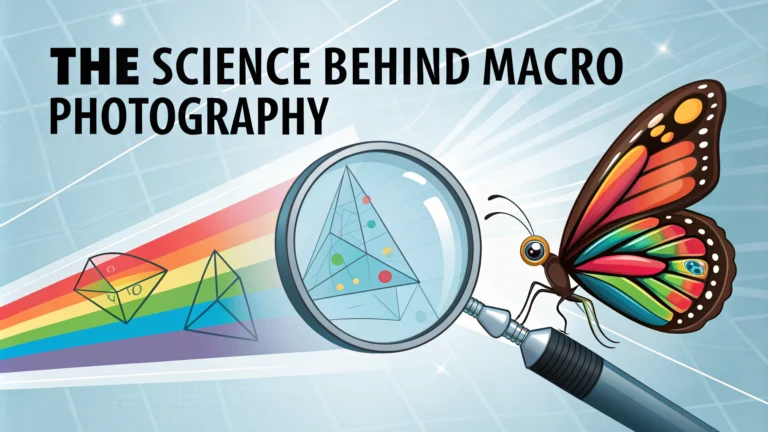Macro photography reveals an extraordinary world of tiny details invisible to our naked eyes.
Understanding the technical aspects behind macro photography helps create stunning close-up images that showcase intricate patterns, textures, and colors.
What Makes a Photo “Macro”
True macro photography achieves a 1:1 reproduction ratio, meaning the subject appears life-sized or larger on the camera’s sensor.
Essential Equipment
- Dedicated macro lens (50mm, 100mm, or 180mm focal lengths)
- Extension tubes for increased magnification
- Ring flash or LED lights for even illumination
- Sturdy tripod with macro rail
- Remote shutter release to minimize vibration
Technical Settings
- Aperture: f/8 to f/16 for adequate depth of field
- ISO: Keep as low as possible (100-400) to minimize noise
- Shutter Speed: 1/200 or faster when shooting handheld
Common Challenges and Solutions
| Challenge | Solution |
|---|---|
| Limited depth of field | Use focus stacking techniques |
| Camera shake | Enable mirror lock-up, use tripod |
| Poor lighting | Use diffused artificial light sources |
Focus Stacking Basics
- Set up your camera on a macro rail
- Take multiple photos, adjusting focus slightly between shots
- Combine images using software like Helicon Focus or Photoshop
Recommended Entry-Level Macro Lenses
- Canon EF 100mm f/2.8L IS USM Macro
- Nikon AF-S VR Micro-NIKKOR 105mm f/2.8G IF-ED
- Sony FE 90mm f/2.8 Macro G OSS
Natural light works best during early morning or late afternoon when the sun provides soft, directional illumination.
Quick Tips for Better Macro Photos
- Clean your lens regularly for maximum sharpness
- Use manual focus for precise control
- Consider using live view for accurate focusing
- Practice with stationary subjects before moving to insects or flowers
For additional guidance, join macro photography communities on platforms like Flickr or 500px to learn from experienced photographers.
Contact professional macro photography organizations like Close-up Photographers Association for workshops and resources.
Advanced Composition Techniques
- Look for leading lines and patterns
- Use the rule of thirds for subject placement
- Include environmental context when relevant
- Experiment with abstract perspectives
Post-Processing Tips
Essential Adjustments
- Fine-tune sharpness without over-processing
- Adjust contrast to enhance texture details
- Remove dust spots and sensor debris
- Consider selective color adjustments
Specialized Macro Subjects
| Subject Type | Special Considerations |
|---|---|
| Water Droplets | Use glycerin for longer-lasting drops |
| Insects | Shoot during early morning when they’re less active |
| Flowers | Choose specimens without damage or blemishes |
Taking Your Skills Further
- Experiment with focus bracketing
- Try reversed lens techniques
- Explore multiple flash setups
- Consider underwater macro photography
Conclusion
Macro photography opens up a fascinating world of possibilities for creative expression. Success comes through understanding technical fundamentals, practicing consistently, and developing patience. Start with basic equipment and gradually expand your toolkit as your skills improve.
Remember that each tiny subject presents unique challenges and opportunities for capturing extraordinary images that reveal nature’s hidden details.
Common Questions About Macro Photography Science
1. What exactly is macro photography magnification?
Macro photography achieves a 1:1 magnification ratio or greater, meaning the subject appears life-sized or larger on the camera sensor.
2. Why do macro photos have such shallow depth of field?
Close focusing distances combined with wider apertures create an extremely thin plane of focus, often just a few millimeters deep in macro photography.
3. What’s the best aperture setting for macro shots?
For most macro subjects, shoot between f/8 and f/16 to balance depth of field and diffraction, adjusting based on subject size and available light.
4. How does focus stacking work in macro photography?
Focus stacking combines multiple images taken at slightly different focus points, merging them in software to create a single photo with greater depth of field.
5. Does sensor size affect macro capabilities?
Smaller sensors actually provide greater effective magnification due to their crop factor, making them advantageous for macro work.
6. What causes lens diffraction in macro photography?
Diffraction occurs when light waves bend around the edges of the aperture blades, becoming more pronounced at smaller apertures (higher f-numbers) and reducing overall image sharpness.
7. How does working distance affect macro shots?
The distance between your lens and subject impacts lighting options, subject comfort (for living subjects), and practical shooting considerations – longer working distances generally provide more flexibility.
8. Why do some macro photos show chromatic aberration?
Close focusing distances amplify color fringing effects as different wavelengths of light focus at slightly different points, particularly noticeable in high-contrast areas.
9. What role does lighting play in macro physics?
The inverse square law becomes particularly significant in macro work – moving a light source just a few centimeters can dramatically change exposure and contrast.
10. How does extension tube math work?
Extension tubes increase magnification based on a simple formula: tube length divided by lens focal length equals additional magnification (e.g., a 25mm tube on a 50mm lens adds 0.5x magnification).











